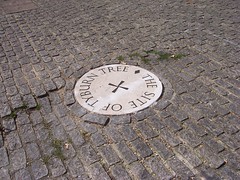
Traduzione by DANILA FORESTI, volontaria di English Gratis. Il testo originale è tratto da una pagina del sito inglese di Wikipedia ed è disponibile nel rispetto della licenza Creative Commons Attribution 2.5 ![]() photo credit: Loz Flowers
photo credit: Loz Flowers

Tyburn (3)
Tyburn (3)
The executions were public spectacles and proved extremely popular, attracting crowds of thousands.
Le esecuzioni erano uno spettacolo pubblico, estremamente popolare, che attirava una folla di migliaia e migliaia di “curiosi”.
The enterprising villagers of Tyburn erected large spectator stands so that as many as possible could see the hangings (for a fee).
Gli intraprendenti abitanti del villaggio di Tyburn eressero ampie tribune affinché il maggior numero possibile di persone potesse assistere alle impiccagioni (accesso a pagamento).
On one occasion, the stands collapsed, reportedly killing and injuring hundreds of people.
In un frangente, gli spalti crollarono, uccidendo e ferendo centinaia di spettatori, secondo quanto riportato.
This did not prove a deterrent, however, and the executions continued to be treated as public holidays, with London apprentices being given the day off for them.
Ciò, tuttavia, non servì come deterrente, e le esecuzioni continuarono ad essere considerate come giornate di festa, tant’è che agli apprendisti Londinesi veniva dato il giorno libero perché vi potessero assistere.
One such event was depicted by William Hogarth in his satirical print, The Idle ‘Prentice Executed at Tyburn (1747).
Uno di tali eventi è stato rappresentato da William Hogarth nella sua stampa satirica “The Idle ‘Prentice Executed at Tyburn (“L’apprendista indolente giustiziato a Tyburn” – 1747).
>>> Tyburn was commonly invoked in euphemisms for capital punishment – for instance, to “take a ride to Tyburn” (or simply “go west”) was to go to one’s hanging, “Lord of the Manor of Tyburn” was the public hangman, “dancing the Tyburn jig” was the act of being hanged, and so on.
Tyburn era comunemente citata nelle allegorie per pena capitale – ad esempio: “fare una passeggiata a Tyburn” (o più semplicemente “andare ad ovest”) significava assistere all’impiccagione di qualcuno; “il Signore del Maniero di Tyuburn” altri non era che il boia; “ballare la giga di Tyburn” equivaleva l’atto di essere impiccato; e via di seguito.
Convicts would be transported to the site in an open ox-cart from Newgate Prison.
I detenuti sarebbero stati tradotti dalla Prigione di Newgate al luogo dell’esecuzione con un carro aperto trainato da buoi.
They were expected to put on a good show, wearing their finest clothes and going to their deaths with insouciance.
Ci si aspettava da loro che mettessero in scena uno spettacolo ben fatto, indossando gli abiti migliori ed andando alla morte con noncuranza.
The crowd would cheer a “good dying”, but would jeer any displays of weakness on the part of the condemned.
La folla avrebbe applaudito una “morte dignitosa” e, per contro, avrebbe dileggiato ogni esternazione di debolezza da parte dei condannati.
On 19 April 1779, clergyman James Hackman was hanged there following his 7 April murder of courtesan and socialite Martha Ray, his former lover, and the mistress of John Montagu, 4th Earl of Sandwich.
Il pastore James Hackman fu impiccato in quel luogo in data 19 aprile 1779, a seguito dell’omicidio, da lui commesso il 7 aprile, della cortigiana e mondana Martha Ray, la sua ex innamorata e mantenuta di John Montague, 4° conte di Sandwich.
The Tyburn gallows were last used on 3 November 1783, when John Austin, a highwayman, was hanged.
Le forche di Tyburn vennero usate per l’ultima volta il 3 novembre 1783, quando venne impiccato il bandito John Austin.
The site of the gallows is now marked by three brass triangles mounted on the pavement on an island in the middle of Edgware Road at its junction with Bayswater Road.
Il luogo della forca è ora contrassegnato da tre triangoli in ottone sistemati sul marciapiedi di una piazzola nel centro di Edgware Road al suo alllacciamento con Bayswater Road.
It is also commemorated by the Tyburn Convent, a Catholic convent dedicated to the memory of martyrs executed there and in other locations for the Catholic faith.
Esso è anche commemorato dal Convento Tyburn, monastero Cattolico dedicato alla memoria dei martiri della fede Cattolica, giustiziati sul luogo ed altrove.
Tyburn today remains the point at which Watling Street, the modern A5 begins.
Tyburn, attualmente, rimane il punto in cui Watling Street (già antica via romana di comunicazione tra Inghilterra e Galles), la moderna A5, ha inizio.
It continues in straight sections to Holyhead.
Essa procede, a tratti rettilinei, sino a Hlyhead.
According to an 1850 publication, the site was at No. 49. Connaught Square.
Secondo una pubblicazione del 1850, il sito si trovava al n° 49 di Connaught Square.

